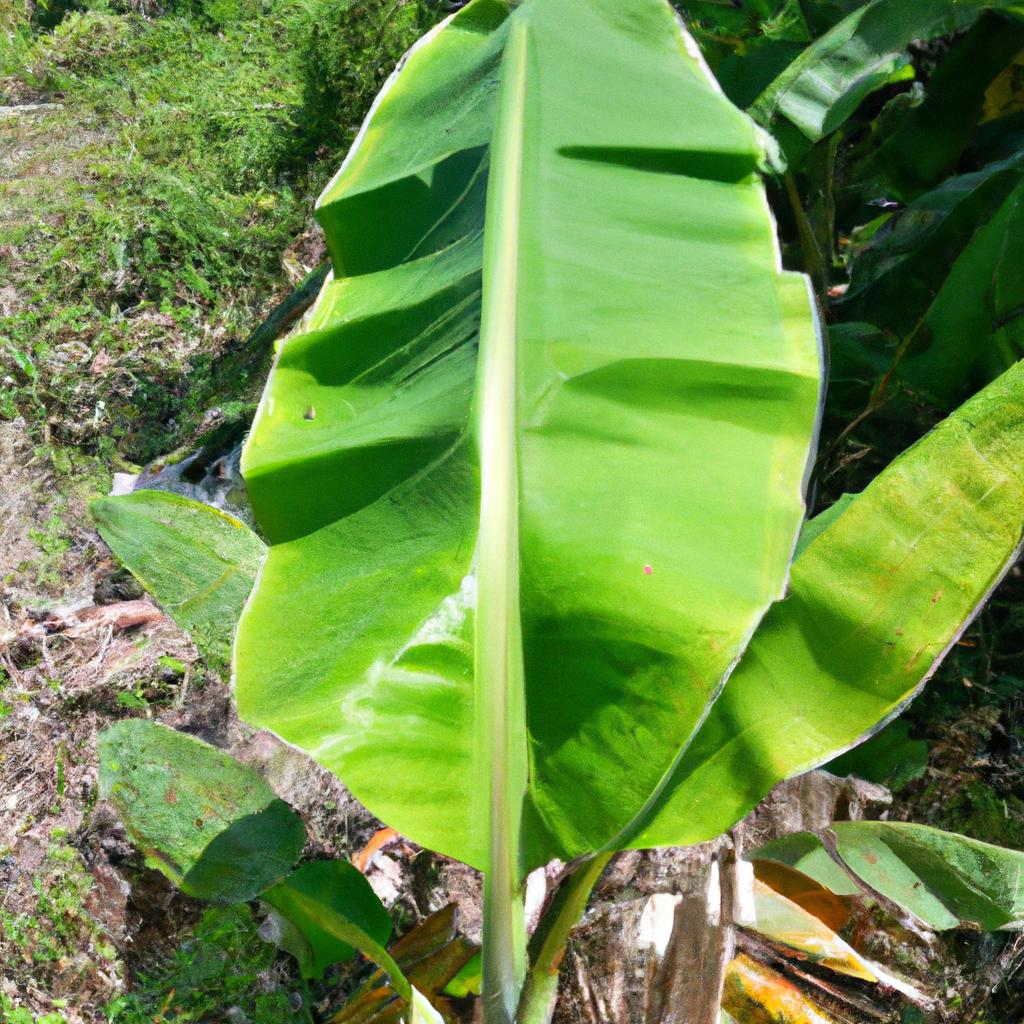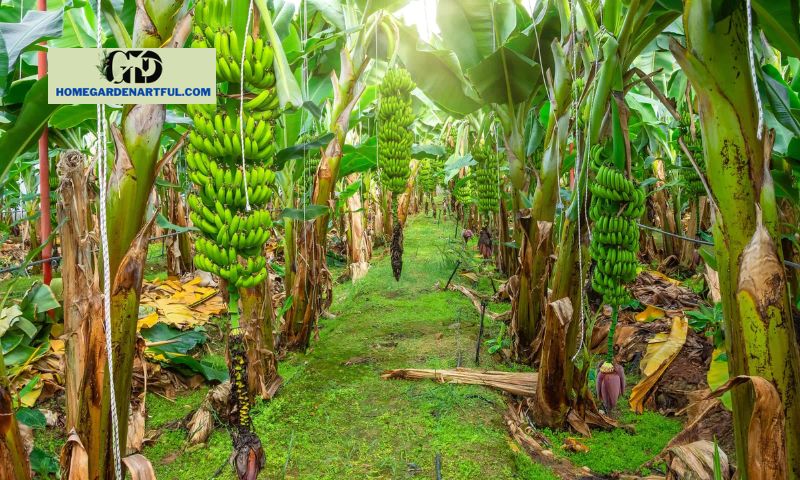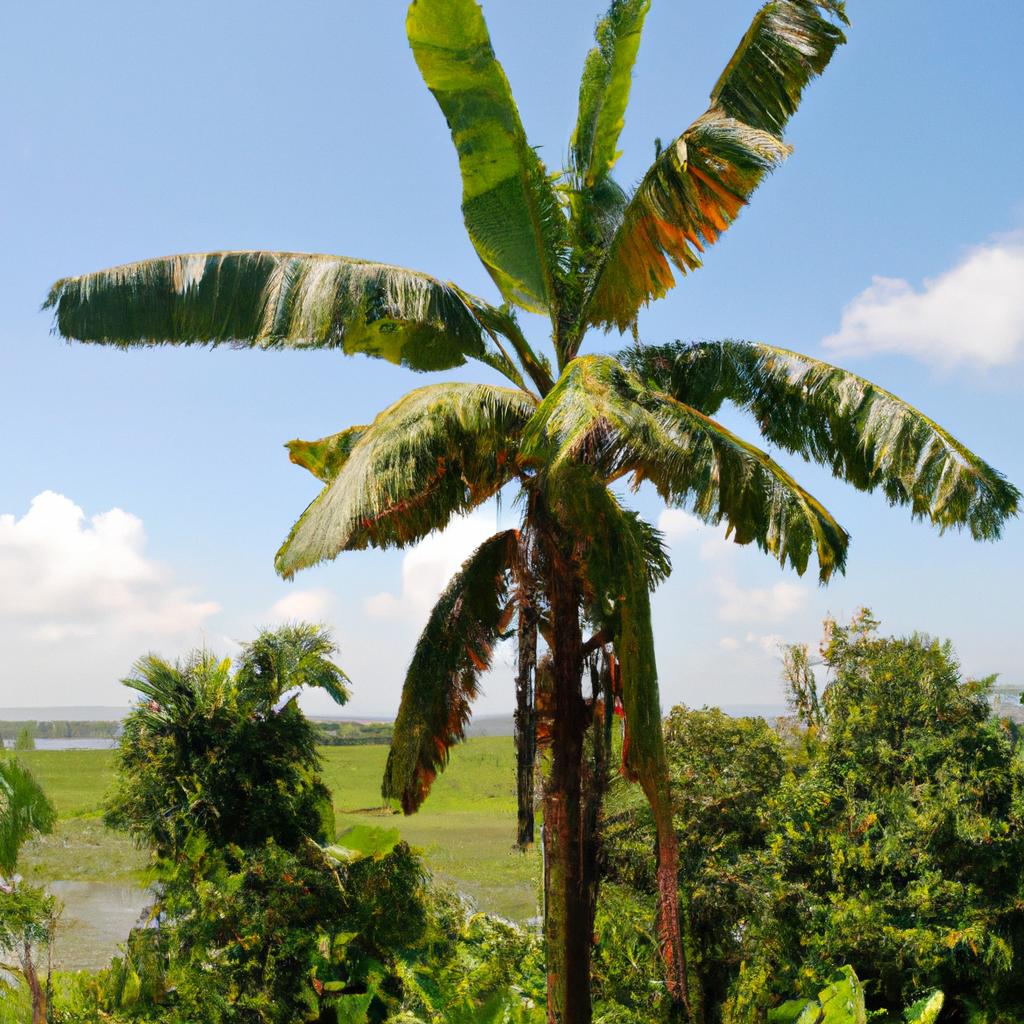Discover the common pests and diseases that threaten banana palm trees. Learn how to identify, prevent, and protect your beloved trees.
The banana palm tree, also known as Musa, is a captivating plant that graces tropical landscapes with its graceful fronds and bountiful fruit. In this article, homegardenartful.com will delve into the world of banana palm trees, exploring their characteristics, cultivation, and the myriad of ways they enrich our lives.
A. Overview of the Banana Palm Tree
Picture a lush tropical paradise – sandy beaches, warm ocean breeze, and an abundance of vibrant foliage. Amidst this picturesque scene, the banana palm tree stands tall, commanding attention with its towering presence. With its slender trunk and large, exotic leaves, it exudes an air of elegance and natural beauty.
Banana palm trees belong to the Musaceae family and are native to Southeast Asia. They have been cultivated for thousands of years, not only for their delicious fruit but also for their aesthetic appeal. These trees can grow up to 20 feet or more, creating a striking presence in any landscape.
B. Importance and Uses of the Banana Palm Tree
Beyond its visual allure, the banana palm tree holds immense cultural, culinary, and economic significance. The fruit produced by these trees is a staple in many diets worldwide, providing essential nutrients and a delightful taste. Bananas are not just a delicious treat; they are a vital source of vitamins, minerals, and dietary fiber, supporting our overall well-being.
Moreover, banana palm trees offer a myriad of uses beyond their fruit. The large, sturdy leaves can be used for various purposes, such as creating natural umbrellas, wrapping food, or even as plates. The trunk fibers are often utilized in the production of textiles, ropes, and paper. In some cultures, banana palm trees hold symbolic value and are used in religious rituals and ceremonies.
Intrigued by the versatility and beauty of the banana palm tree? Join me as we explore further into the characteristics and types of these remarkable tropical wonders. Stay tuned for the upcoming sections where we will delve into planting and growing techniques, harvesting methods, common pests and diseases, and more. Let’s unlock the secrets of this magnificent tree together!
Stay informed and inspired with the latest gardening tips and tricks at homegardenArtful.com.
Characteristics and Types of Banana Palm Trees

A. Description of the Physical Features of Banana Palm Trees
Banana palm trees possess distinct physical features that make them easily recognizable in tropical landscapes. These majestic trees boast a slender yet strong trunk, which is actually a pseudostem comprised of tightly overlapping leaf sheaths. The trunk can vary in color, ranging from shades of green to brownish hues, adding to the tree’s visual appeal.
One of the most striking aspects of banana palm trees is their large, lush leaves. These leaves, often referred to as fronds, are elongated and fan-shaped, creating a dramatic display as they sway gently in the breeze. The vibrant green color of the leaves adds a touch of vibrancy to any garden or plantation.
B. Different Types and Varieties of Banana Palm Trees

Banana palm trees come in a variety of types and cultivars, each with its unique characteristics and purposes. Here are a few popular types:
1. Cavendish Bananas
Cavendish bananas are widely recognized and consumed across the globe. They are known for their sweet flavor, creamy texture, and yellow peel. Cavendish bananas are the most commonly cultivated type due to their resistance to Panama disease, a fungal infection that affects other banana varieties.
2. Plantain Bananas
Plantain bananas are larger than regular bananas and are typically cooked before consumption. They have a starchy texture and are often used in savory dishes. Plantains are a staple in many tropical cuisines and provide a rich source of carbohydrates.
3. Lady Finger Bananas
Lady finger bananas, also known as baby bananas, are small and slender in size. They are sweet and fragrant, making them a delightful snack or addition to desserts. Lady finger bananas are often used in smoothies, baked goods, or enjoyed on their own.
These are just a few examples of the vast array of banana palm tree types and varieties that exist worldwide. As we continue our exploration, we will uncover the secrets to successfully planting and growing banana palm trees. Get ready to embark on a tropical gardening adventure like no other!
Stay tuned for more gardening expertise and inspiration at homegardenArtful.com.
Planting and Growing Banana Palm Trees

Ideal Climate and Conditions for Banana Palm Tree Cultivation
To ensure successful banana palm tree cultivation, it is crucial to understand the ideal climate and conditions these tropical beauties thrive in. Banana palm trees prefer warm, tropical climates with temperatures ranging between 75°F and 95°F (24°C and 35°C). They require a minimum of 10 hours of sunlight each day to promote healthy growth and fruit production. Additionally, banana palm trees thrive in well-drained soil that is rich in organic matter.
Steps to Planting and Establishing Banana Palm Trees
Are you ready to embark on your banana palm tree journey? Follow these steps to plant and establish these majestic plants in your garden:
- Choose the right variety: Select a banana palm tree variety that suits your climate and desired fruit characteristics. Popular varieties include Cavendish, Lady Finger, and Dwarf Cavendish.
- Prepare the site: Ensure the planting site receives ample sunlight and has well-drained soil. Remove any weeds or grass and dig a hole that is twice the width and depth of the root ball.
- Plant with care: Gently place the banana palm tree into the hole, ensuring that the top of the root ball is level with or slightly above the soil surface. Backfill the hole with soil and tamp it down gently to remove air pockets.
- Water thoroughly: After planting, water the tree thoroughly, ensuring the soil is evenly moist. Water regularly to keep the soil consistently moist, but avoid overwatering, as it can lead to root rot.
Proper Care and Maintenance Techniques for Healthy Growth
To promote the health and vitality of your banana palm trees, follow these care and maintenance techniques:
- Fertilize regularly: Apply a balanced, slow-release fertilizer every two to three months during the growing season to provide essential nutrients for robust growth.
- Mulch the base: Apply a layer of organic mulch around the base of the tree to retain moisture, suppress weed growth, and regulate soil temperature.
- Prune wisely: Remove dead or damaged leaves regularly to maintain the plant’s aesthetic appeal. Additionally, prune excess suckers to allow the main stem to focus its energy on fruit production.
- Protect from extreme cold: If you live in an area with occasional frost or cold temperatures, consider covering your banana palm trees with a protective cloth or blanket to shield them from potential damage.
By following these planting, establishing, and maintenance techniques, you will be well on your way to cultivating thriving banana palm trees in your garden. In the next section, we will explore the rewarding process of harvesting and utilizing these tropical wonders. Stay tuned!
Discover more expert gardening advice and tips at homegardenArtful.com.
Harvesting and Utilizing Banana Palm Trees
Banana palm trees are not only admired for their beauty but also for the delectable fruit they bear. In this section, we will explore the art of harvesting bananas and discover the diverse applications of various parts of the banana palm tree.
A. Identifying the Right Time for Harvesting Bananas
Harvesting bananas at the optimal time ensures the perfect balance between flavor and texture. The color of the fruit is a reliable indicator of its ripeness. Green bananas are typically unripe, while yellow bananas offer a sweet taste and creamy texture. Look for bananas with a vibrant yellow hue, with perhaps a few green tips, indicating they are at their prime for consumption.
B. Techniques for Harvesting Banana Bunches
Harvesting banana bunches requires a delicate touch to avoid damaging the fruit or the tree itself. Start by carefully cutting the bunch from the tree using a sharp knife or secateurs. It is crucial to leave a portion of the stem intact to maintain the plant’s health and encourage future growth. Handling the harvested bunches with care ensures that the fruit remains undamaged and ready for consumption or further processing.
C. Various Uses of Banana Palm Tree Parts
Banana palm trees offer a wealth of resources beyond their delicious fruit. The leaves, known as “fronds,” are remarkably versatile and have been utilized for centuries in various ways. These large, sturdy leaves can be used as natural umbrellas, providing shade on sunny days. They are also employed as eco-friendly food wrappers or makeshift plates, adding a touch of tropical elegance to culinary presentations.
The trunk fibers of banana palm trees are remarkably strong and have found their place in the creation of textiles, ropes, and paper. These fibers are harvested and processed to create sustainable materials that have a minimal environmental impact. By utilizing these fibers, we can reduce our reliance on synthetic materials and embrace a more eco-conscious lifestyle.
Lastly, let’s not forget the star of the show – the banana fruit itself. Bursting with flavor and essential nutrients, bananas are enjoyed fresh, added to smoothies, baked into scrumptious desserts, or incorporated into savory dishes. Their versatility in the kitchen knows no bounds, making them a beloved ingredient in countless recipes worldwide.
Intrigued by the endless possibilities of the banana palm tree? Join me in the upcoming sections as we explore common pests and diseases that affect these tropical wonders, ensuring that we can protect and nurture our beloved banana palm trees. Stay tuned for more insightful tips and knowledge!
For more expert advice and inspiration on home gardening, visit homegardenArtful.com.
Conclusion
As we conclude our exploration of the captivating banana palm tree, we are left in awe of its versatility, beauty, and the numerous ways it enriches our lives. From its elegant fronds swaying in the breeze to the delectable fruit it bears, the banana palm tree truly embodies the essence of tropical abundance.
Throughout this article, we have discovered the various facets of the banana palm tree, from its physical characteristics and different types to the art of planting and caring for these remarkable trees. We have also explored the bountiful harvests and the multitude of uses for different parts of the tree, be it the nutritious fruit, the versatile leaves, or the fibers of the trunk.
Additionally, we have discussed the common pests and diseases that can pose challenges to banana palm tree cultivation. By understanding these potential threats and implementing identification and prevention methods, we can ensure the health and longevity of our beloved trees.
In conclusion, the banana palm tree is a true marvel of nature, offering both aesthetic appeal and practical benefits. Whether you dream of creating a tropical oasis in your backyard or simply want to enjoy the delicious taste of homegrown bananas, the banana palm tree is a perfect choice.
So, why not embark on your own banana palm tree journey? Start by planting a sapling, nurturing it with care, and witness the rewards it brings. Let the banana palm tree become a centerpiece of your garden, a symbol of tropical enchantment, and a source of delight for years to come.
Thank you for joining me on this exploration of the banana palm tree. To continue your journey into the world of gardening and discover more tips and inspiration, visit homegardenArtful.com.
Uncover the wonders of nature and elevate your gardening skills with homegardenArtful.com.


